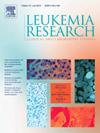Clinical relevance of long non-coding RNA in acute myeloid leukemia: A systematic review with meta-analysis
IF 2.1
4区 医学
Q3 HEMATOLOGY
引用次数: 0
Abstract
Background
Long noncoding RNAs (lncRNAs) may function as prognostic biomarkers in acute myeloid leukaemia (AML). However, it is still unknown exactly how significant lncRNAs are for the prognosis of AML. With a focus on their prognostic and therapeutic potential, the study aimed to provide a comprehensive review of the literature regarding the role of lncRNAs in AML.
Method
Pub Med, The Cochrane Library, Embase, Science Direct, Web of science, Scopus, and Google scholar were searched until November, 2023. Original publications of any type exploring the prognostic and therapeutic potential of lncRNAs in AML patients were included. Heterogeneity and publication bias were examined using the I2 test and a funnel plot, respectively. To quantify the relationship between various lncRNA expression in AML patient survival, odds ratios (ORs) or hazards ratios (HRs) with 95 % confidence intervals (CIs) were pooled. Quality of studies was assessed using the Critical Appraisal Checklists for Studies created by the Joanna Briggs Institute (JBI).
Results
Twenty-seven studies including 5665 subjects were selected for the final analysis. In patients with AML, abnormal lncRNA expression has been associated with significant worse overall survival (pooled HR = 2.05, 95 % CI = 1.79–2.30, P <0.001), shorter disease-free survival (pooled HR = 2.17, 95 % CI = 1.13–3.22, P< 0.001), and lower complete remission rate (pooled HR = 0.27, 95 % CI = 0.11–0.43, P< 0.001). Poor prognoses have been attributed to increased expression of HOX transcript antisense intergenic RNA (HOTAIR), Promoter Of CDKN1A Antisense DNA Damage Activated RNA (PANDAR), Metastasis Associated Lung Adenocarcinoma Transcript 1 (MALAT1), RP11–222K16.2, Taurine Upregulated Gene 1 (TUG1), Small Nucleolar RNA Host Gene 5 (SNHG5), Growth Arrest Specific 5 (GAS5), and H19 and decreased expression of IGF1R Antisense Imprinted Non-Protein Coding RNA (IRAIN).
Conclusion
The prognoses of AML patients are significantly associated with abnormally expressed lncRNAs, which may be used as prognostic indicators for predicting the patient outcomes.
长非编码 RNA 在急性髓性白血病中的临床意义:系统回顾与荟萃分析
背景长非编码RNA(lncRNA)可作为急性髓性白血病(AML)的预后生物标志物。然而,目前尚不清楚lncRNA对急性髓性白血病预后的确切意义。本研究以其预后和治疗潜力为重点,旨在对有关lncRNAs在AML中作用的文献进行全面综述。研究方法检索了Pub Med、The Cochrane Library、Embase、Science Direct、Web of science、Scopus和Google scholar,直至2023年11月。纳入了探讨 lncRNAs 在急性髓细胞性白血病患者中的预后和治疗潜力的任何类型的原始出版物。分别使用 I2 检验和漏斗图检验异质性和发表偏倚。为了量化各种lncRNA表达与AML患者生存之间的关系,对带有95%置信区间(CI)的几率比(OR)或危险比(HR)进行了汇总。研究质量采用乔安娜-布里格斯研究所(JBI)制定的 "研究关键评估清单"(Critical Appraisal Checklists for Studies)进行评估。在急性髓细胞性白血病患者中,lncRNA表达异常与较差的总生存期(汇总HR = 2.05,95 % CI = 1.79-2.30,P<0.001)、较短的无病生存期(汇总HR = 2.17,95 % CI = 1.13-3.22,P<0.001)和较低的完全缓解率(汇总HR = 0.27,95 % CI = 0.11-0.43,P<0.001)明显相关。预后不良的原因是 HOX 转录本反义基因间 RNA(HOTAIR)、Promoter Of CDKN1A Antisense DNA Damage Activated RNA(PANDAR)、Metastasis Associated Lung Adenocarcinoma Transcript 1(MALAT1)、RP11-222K16.2、牛磺酸上调基因1(TUG1)、小核极RNA宿主基因5(SNHG5)、生长停滞特异性5(GAS5)和H19的表达以及IGF1R反义印迹非蛋白编码RNA(IRAIN)的表达减少。
本文章由计算机程序翻译,如有差异,请以英文原文为准。
求助全文
约1分钟内获得全文
求助全文
来源期刊

Leukemia research
医学-血液学
CiteScore
4.00
自引率
3.70%
发文量
259
审稿时长
1 months
期刊介绍:
Leukemia Research an international journal which brings comprehensive and current information to all health care professionals involved in basic and applied clinical research in hematological malignancies. The editors encourage the submission of articles relevant to hematological malignancies. The Journal scope includes reporting studies of cellular and molecular biology, genetics, immunology, epidemiology, clinical evaluation, and therapy of these diseases.
 求助内容:
求助内容: 应助结果提醒方式:
应助结果提醒方式:


